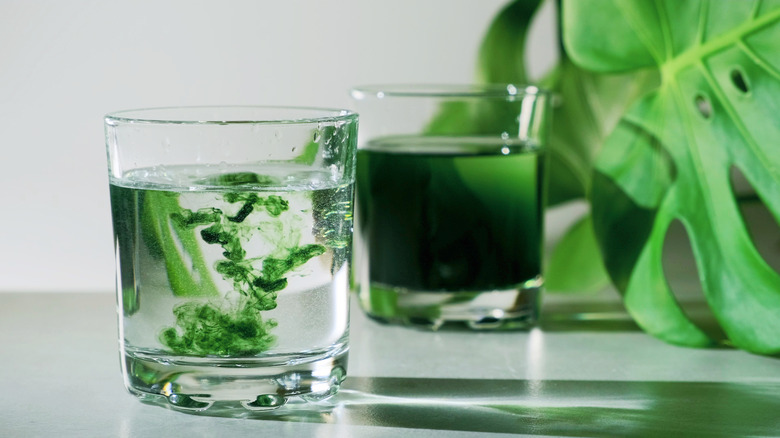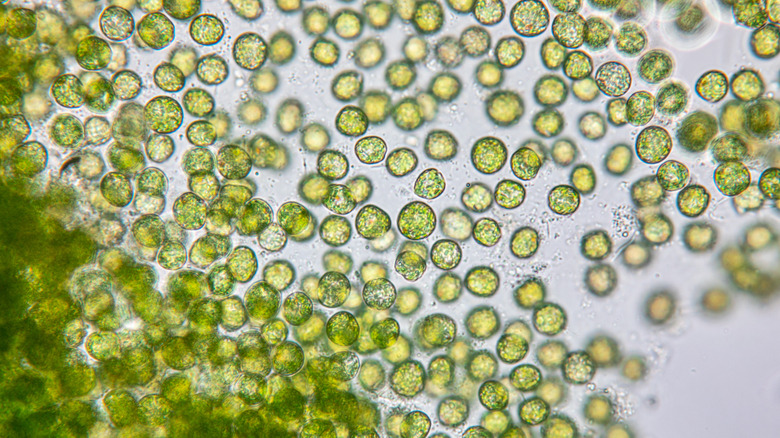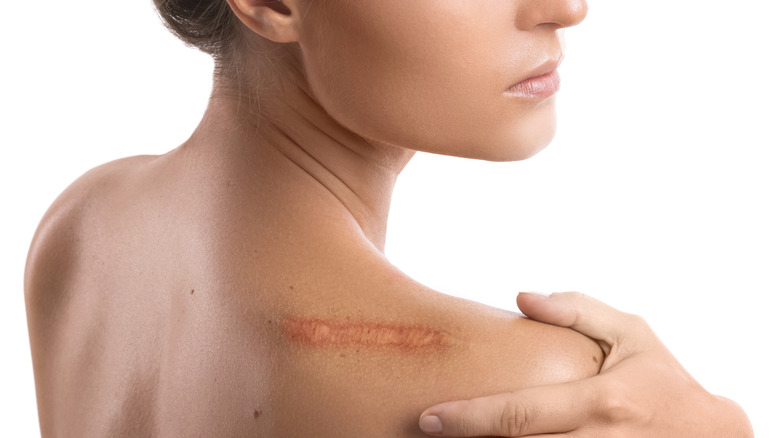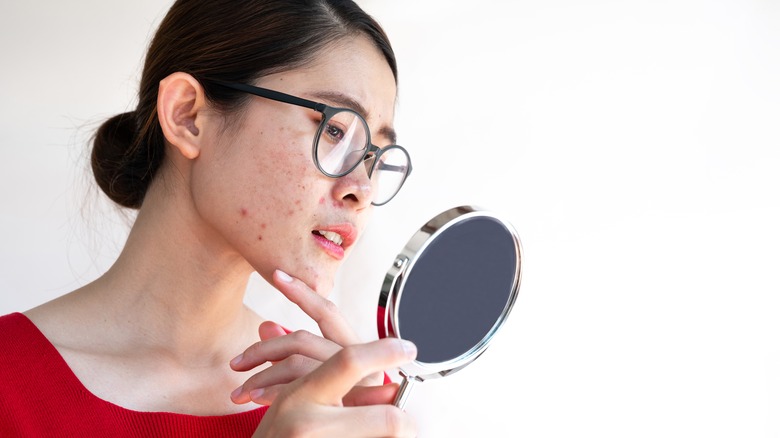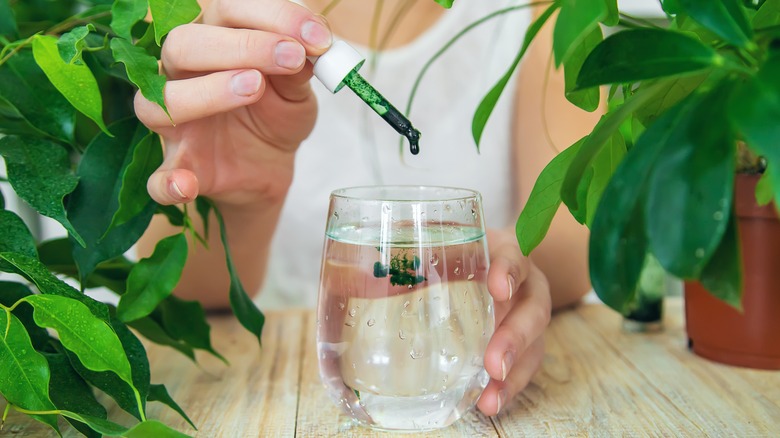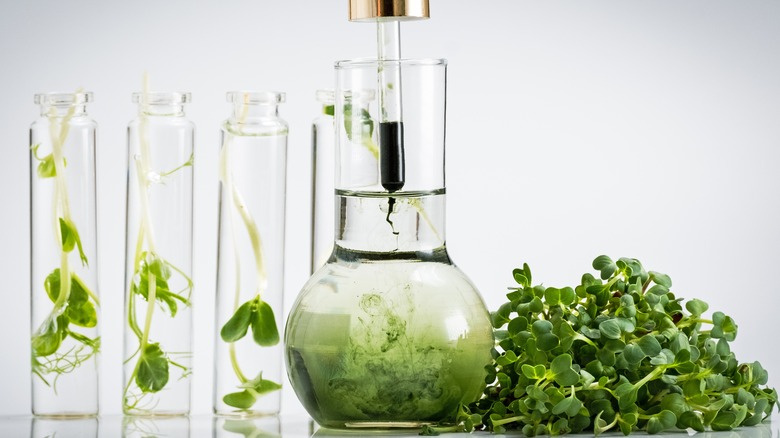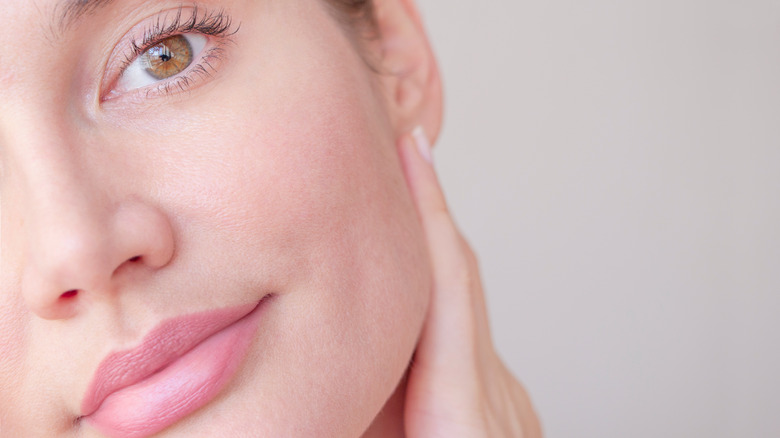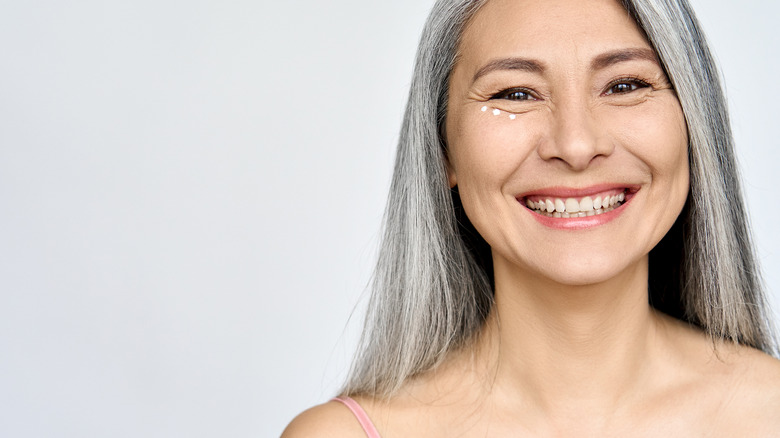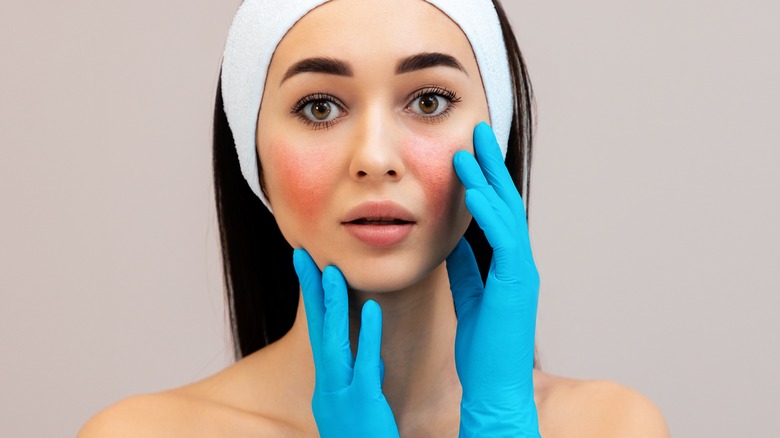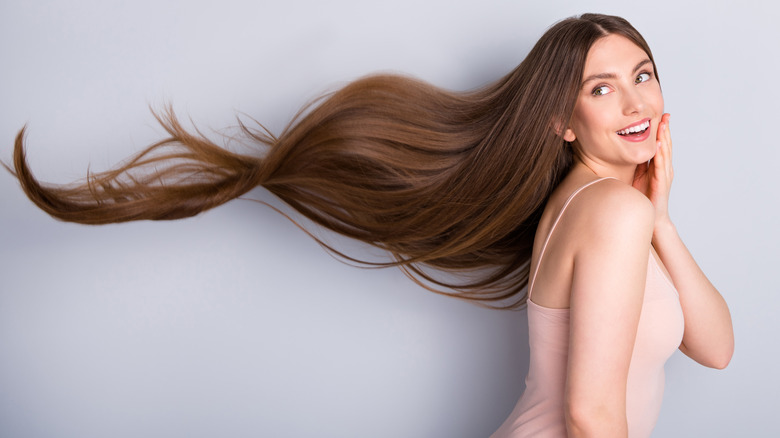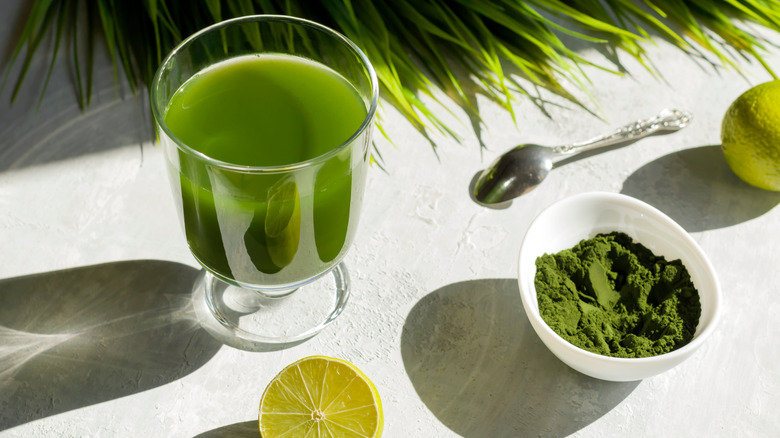Benefits Of Liquid Chlorophyll For Your Hair And Skin
Chlorophyll: it sounds more like Bill Nye the Science Guy than a prominent beauty trend. Nevertheless, liquid chlorophyll is trending, with TikTokers dosing their H2O in hopes of cultivating clear, radiant skin, among other health benefits. This might have left you wondering whether to jump on the green-drink bandwagon. If so, here's what you need to know.
First off, if you do, you'll join the ranks of celebrities like Reese Witherspoon and Kourtney Kardashian. Both have been sipping the green drink for years for help with breakouts and quick nutrient infusions.
Even if that alone is enough to get you jumping on the liquid chlorophyll bandwagon, know that the supplement isn't just popular with celebrities. In fact #chlorophyll has racked up over 500 million views on TikTok. The claims vary, but here's the gist: swirl up to 15 (aesthetically pleasing) green drops into your water for increased energy, clearer skin, fewer wrinkles, lustrous hair, and much more.
Before you dive in, we're here to help you separate fact from fiction, truth from ... well, maybe truth, but truth that needs more research. Even trends — actually, especially trends — need fact-checking from time to time.
What is chlorophyll?
Think back to science class. Chlorophyll is a pigment; it gives plants like spinach and parsley their verdant green color. But it's also responsible for the absorption of sunlight that powers photosynthesis and gives plants their energy. In short, it's a powerful little molecule (via Oregon State University).
Now for the semantics: the chlorophyll found in plants isn't water soluble, so the drops TikTokers are dissolving in their water are actually chlorophyllin, "a semi-synthetic mixture of water-soluble sodium copper salts derived from chlorophyll," per Oregon State University. Chlorophyllin can be found in tablets, topical ointments, and, of course, the liquid supplements that currently have TikTokers talking.
We naturally ingest chlorophyll when we eat vegetables and leafy greens. One cup of spinach provides a little less than 24 milligrams of chlorophyll, but those who imbibe in liquid chlorophyll often sip between 100 to 300 milligrams a day (via Oregon State University). In case you lost count, that's around 10 to 12 cups of spinach, daily. That's a lot of health benefits!
If that much salad doesn't appeal to you, then liquid chlorophyll can help fill the nutrient gap. Although the current research is slim, with many dieticians and physicians suggesting a trip to the produce aisle instead of the vitamin aisle, liquid chlorophyll has a huge list of purported benefits. Whether you prefer your chlorophyll on your plate or in a glass, it's safe to say that leafy greens are good for us. But does that internal health show up on our skin? That's the big question.
Chlorophyll heals skin
Chlorophyll may be finding fame on TikTok now, but it has been used since the 1940s and '50s to help heal wounds and reduce inflammation (via Oregon State University). Most studies on the wound-healing effects of chlorophyll have been topical applications, such as ointments that contain the active ingredient chlorophyllin. Its use topically has been found to "promote healing," maintain "optimal circulation," and "reduce odor," with the affected tissue benefiting from "nutritive elements" (via Wound Management & Prevention).
But what about liquid chlorophyll? Can this trendsetting green liquid provide the same benefits? For InStyle, Nicholas Perricone, M.D., a dermatologist and founder of Perricone MD, confirms that "chlorophyll is a powerful antioxidant with both anti-inflammatory and anti-bacterial properties." Not only that, but he further explains that chlorophyll provides "excellent health benefits both internally and when used in topical applications."
Sounds very promising for those hoping to heal their skin by drinking their greens. For acne and rosacea sufferers, healing the skin is an important step in clearing skin and improving skin tone. But right now, more studies need to be done in order to determine the real, measurable effects of liquid chlorophyll on the skin, including with the healing of wounds and abrasions.
Keeps bad smells at bay
Chlorophyll won't make you smell like a bed of roses, but it might help assuage bad body odors from the inside out. Studies show that liquid chlorophyll's antimicrobial properties can help control fecal and urine odors (especially important for those with an ostomy bag) and may even keep halitosis, or bad breath, at bay.
Don't give up your regular deodorant yet, though. To date, the research on whether fecal odors are actually improved after taking liquid chlorophyll is mixed. Still, a study in Life Sciences seems to confirm a measurable improvement in those with trimethylaminuria and its associated fishy-smelling odor.
The results on bad breath are mixed, too, with researchers suggesting that liquid chlorophyll's antimicrobial properties work to suppress a strain of yeast that can cause bad breath (via ResearchGate). However, the study focused on chlorophyll's antimicrobial activity during root canals, not on halitosis. But that didn't stop Clorets, a now-discontinued gum that contained chlorophyll, from promising "kissing sweet" fresh breath thanks to the active ingredient.
Of course, anecdotal evidence abounds. On TikTok, there are users like @suedebrooks who swear their sweat smells like "sugarplum ... so yummy" after taking liquid supplements for only four days. Meanwhile, over at The Cut, a writer and hot-yoga enthusiast gave a decidedly lukewarm report that they may have smelled a little less, well, stinky after their class. So, is liquid chlorophyll an all-body breath mint after all? Until the research catches up, the jury is still out, but it may be worth a shot on an individual basis.
It can battle acne
If you're wondering how this whole TikTok trend began, it's pretty safe to say that acne is behind the craze. And it could even be traced down to a single TikTok video: user @ellietaylor929 shared a video of her knocking back a chlorophyll-spiked green drink daily for a week, as well as its subsequent positive effect on her skin. Now that the social media platform is awash with the emerald-hued elixir, it's safe to say that a good number of them focus on the most bothersome of skin ailments: pimples.
There are a few of chlorophyll's qualities at work here. "Chlorophyll is thought to help the skin in several ways, providing antioxidant benefits and neutralizing free radical damage caused by environmental aggressors, like UV light exposure and pollution," Dr. Joshua Zeichner, director of cosmetic and clinical research at Mount Sinai Hospital, tells Vogue.
Dr. Zeichner explains further that "there's some data that topical chlorophyll is useful in patients with oily and acne-prone skin, helping to minimize the appearance of pores." However, all of the current research focuses on topical applications, not on oral supplements. So, are TikTokers just ahead of the curve? Or is social media once again showing viewers a filtered reality?
Currently, more research needs to be done on whether ingesting chlorophyll has the same benefits that topical ointments do, which has studies — including one on photodynamic therapy and an eight-week clinical trial — backing their very promising findings.
Chlorophyll may fight inflammation
Chlorophyll's anti-inflammatory properties may be its most widely documented benefit, and it's one that contributes to our overall health. Inflammation and aging go hand-in-hand, as suggested by a study in the Journal of Physiology. Although the study doesn't look at chlorophyll specifically, it does come to the conclusion that "targeting inflammation, either with drugs or exercise, may prove to constitute an efficient anti-aging cure." So, with that in mind: can liquid chlorophyll help?
The outlook is good. One study in the scientific journal Inflammation touted chlorophyll's "valuable and abundantly available anti-inflammatory agents" and noted that it is "promising for the development of phytomedicine or conventional medicine to treat inflammation and related diseases." Meanwhile, another study in the journal Marine Drugs looked at microalgal extracts and found that they had measurable anti-inflammatory properties that might lead to future applications in the cosmeceutical sector (that's cosmetics with bioactive ingredients).
What's more, Gretchen Frieling, M.D., a dermatopathologist based in the U.S., explains that chlorophyll-rich foods can help "the body heal more efficiently and ward off inflammation, irritation, and signs of aging" (via InStyle). If your salad can do that, then perhaps it follows that chlorophyll drops can, too, meaning that we have a secret weapon on our hands.
So, what does it all mean for those of us looking to keep our pores and pimples small — or non-existent? Banishing bacteria and reducing inflammation could potentially help a whole range of skin issues. Hopefully, one day we'll have more conclusive answers, but right now, science is still catching up to the trend.
Chlorophyll provides antioxidants
Antioxidants, like those found in chlorophyll, can be a powerful addition to our diets. They protect our vital organs and scavenge free radicals — those pesky unstable atoms that cause cell damage – that promote longevity and anti-aging. In short: antioxidants contribute to our overall health.
For instance, dermatologist Purvisha Patel explains that "Chlorophyll is high in vitamins C, A, E, and K, and it has antioxidant properties" (via Allure). The result may be a one-two punch for skincare: the antioxidants help fight free radicals, while the body gets a dose of essential nutrients that gives skin the opportunity to heal and repair.
Patel suggests using "liquid chlorophyll ... if you have inflammatory acne that is red and inflamed," as antioxidants like chlorophyll help reduce inflammation. (But those using liquid chlorophyll to clear their skin, take note: she also warns that its use may prove to be fruitless if you try using it on "deep, cystic acne.")
There is even more good news for those who like to sip their leafy greens: a study in the Journal of Food Science has shown that chlorophyll retains its antioxidant and free-radical-scavenging properties whether we juice our vegetables, eat a big salad, or simply add a few drops to our water daily. Think of it as a choose-your-own-adventure to skincare and overall health.
Chlorophyll has pore-shrinking abilities
Sufferers of large pores, take note. There are quite a few reasons your pores may look the way they do. Genetics. Excess oil, also known as sebum. Aging skin that has lost collagen and elasticity. Sun damage. Even large hair follicles can cause visible pores. And when pores get clogged, causing whiteheads and blackheads, the real trouble begins.
Anecdotally, liquid chlorophyll may provide some relief for those seeking flawless skin. Many who regularly sip liquid chlorophyll report an improvement in their skin tone, which they then report on social media, of course. But currently, scientific studies have only focused on using chlorophyll topically. This can be seen in a study in the Journal of Drugs in Dermatology, where, in just three weeks, a topical gel containing chlorophyllin proved effective in reducing both acne and pore size in those who previously had large, visible pores.
But on the other end of the spectrum, Purvisha Patel, a board-certified dermatologist, tells Allure that "there are many variables when using it topically, including the breakdown of the ingredient and oxidization." That's why, in her opinion, "taking it orally is a better mode of taking it." This is great (leafy green) food for thought for anyone looking to reap chlorophyll's benefits.
Chlorophyll may help slow, repair, and prevent skin damage
Wrinkles, fine lines, hyperpigmentation: the effects of aging are tough on our skin. Thankfully, several studies, including ones in the Journal of Drugs in Dermatology and Journal of Lifestyle Medicine, show that chlorophyll can help reverse the signs of aging by fighting free radicals and giving skin antioxidant benefits.
So far, most studies have focused on topical applications. But one Korean study tested the use of a chlorophyll supplement on women over 45 and measured changes in wrinkles and skin elasticity over a 90-day period. The extract "significantly" improved skin texture and signs of aging and even increased collagen production in the skin that was photoaged (read: sun-damaged). As an added bonus, the research suggests that liquid chlorophyll doesn't just repair existing skin damage but also that it can help prevent it. If true, this could be life-changing for many.
Another study, this time in PeerJ, found that oxidative stress was decreased in roundworms that ingested chlorophyll, producing "antioxidant and longevity-promoting activities inside the body." Oxidative stress happens when an excess of free radicals damages cells and DNA, contributing to signs of aging. The researchers suggested that based on the study, the results may translate to humans, too.
For those fighting the signs of aging (and aren't we all?), this is encouraging news. The bottom line is that the benefits of ingesting leafy greens, whether taken as a supplement or a salad, shows up on our skin. So, don't give up on your favorite anti-aging cream just yet, but maybe consider adding some more chlorophyll to your life.
It also helps with rosacea
Chlorophyll's anti-inflammatory properties are perfectly suited to tackle rosacea, an inflammatory skin condition. A recent study in the Journal of Drugs in Dermatology shows a marked improvement in those who used a topical chlorophyll cream, thanks to its "antioxidant, anti-inflammatory, and anti-bacterial properties."
So, what about liquid chlorophyll? Can this magic green drink provide the same benefits? Just like with acne, there are plenty of TikTokers out there documenting the positive effects of liquid chlorophyll on their rosacea. One example is user @lenamaiah, whose video that captures her preparing and sipping chlorophyll-spiked water has racked up over five million views. (She posted the video a second time, which has more than two million views for a combined total of over seven million views.) She begins the video by listing chlorophyll's benefits, and, at the end, she claims that her rosacea has significantly improved since adding chlorophyll drops to her daily regimen.
She's certainly not alone. Anecdotally, many TikTokers who suffer from rosacea are finding relief from liquid chlorophyll, but the reason they have found relief won't be properly understood until more research is done.
Promotes hair growth
When it comes to liquid chlorophyll, skincare has stolen the show, but there are still some haircare enthusiasts who have hopped aboard the chlorophyll bandwagon. Haircare brands like Rahua have begun adding this ingredient to their products to "deeply nourish the hair and scalp."
Those who use chlorophyll to keep their hair healthy point out the antioxidant's vitamins and minerals, like calcium and potassium, and their positive effect on hair and nails. Add to that claims that chlorophyll will "slow down the progression of gray hair by continuously producing melanin in pigment cells in hair follicles" and chlorophyll begins to sound almost too good to be true (via Naturally Curly).
A quick sweep of TikTok also finds a number of people using liquid chlorophyll to dye their hair a grassy shade of green, but this is only related to its pigment and not its health benefits. Ultimately, more studies are needed to prove chlorophyll's effectiveness on hair growth and gray hair. But if you just can't wait for the science to catch up, getting more leafy greens, however you do it, is never going to hurt. You may find yourself benefitting from many positive skincare and health perks.
The risks of adding chlorophyll to your skincare routine
Of course, with benefits come risks. First, the good news: both chlorophyll and chlorophyllin have been used therapeutically for more than 50 years without any reported toxic effects (via Oregon State University). However, Emily Clairmont, a registered dietitian at the University of Vermont Medical Center, reports to Forbes that there is "certainly a risk of toxicity" for those taking the liquid supplement as a "standard serving size of chlorophyllin contains more than the recommended intake for copper."
Now for the (not-so-)bad news: there are a few notable side effects. For those who have added liquid chlorophyll to their regimen, research has found increased photosensitivity (sensitivity to sunlight and UV rays), a side effect that's especially important to note for those hoping to reverse sun damage and signs of aging by taking the supplement. So, if you imbibe, be sure to slather on the sunscreen.
There are a few other causes for concern. For instance, it can interfere with some medications, so be sure to check with your healthcare practitioner first. It can also cause tummy troubles, like diarrhea, and tint your urine or feces green (via Forbes Health). But overall, as long as you're not pregnant or breastfeeding, the consensus is that liquid chlorophyll is safe to use.
One sure sign that healthy habits are on the upswing: getting your greens has never been trendier. We'll raise a green-hued glass to that.
